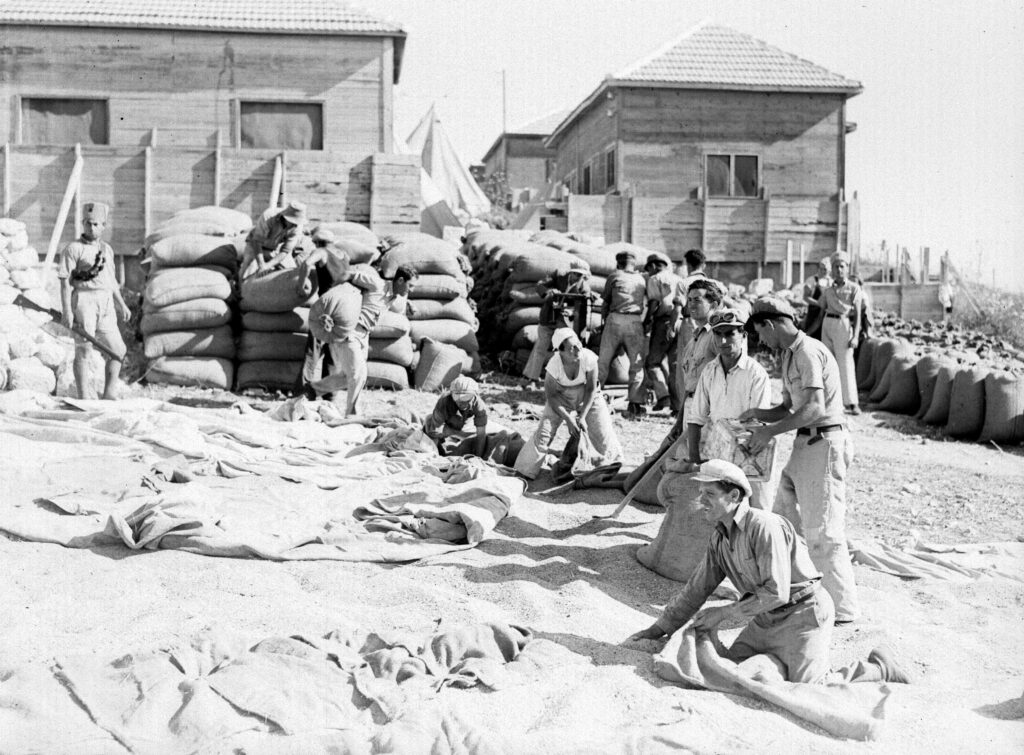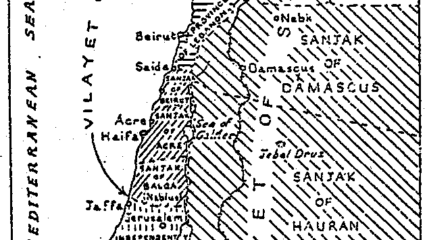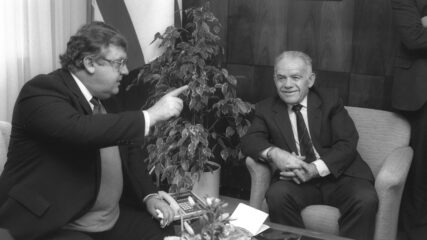March 2025
CIE has compiled the following list of books and articles, including some available on our website, to guide understanding of the New Yishuv during the period from the 1880s until the founding of the State of Israel in 1948.
Books
Adelman, Jonathan R. The Rise of Israel: A History of a Revolutionary State. Milton Park, Abingdon, Oxon: Routledge, 2008.
Alianov-Rautenberg, Viola. No Longer Ladies and Gentlemen: Gender and the German-Jewish Migration to Mandatory Palestine. Stanford, CA: Stanford University Press, 2023.
Kidron, Anat, and Shuli Linder Yarkony. The Jewish Community of Acre in Mandatory Palestine: The Story of a Forgotten Community. Berlin: De Gruyter Oldenbourg, 2024.
Arian, Alan, and Assaf Razin. Israel: A Developing Society. Assen, Netherlands: Van Gorcum, 1980.
Bar-Gal, Yoram. Propaganda and Zionist Education: The Jewish National Fund, 1924-1947. Rochester, NY: University of Rochester, 2003.
Bauer, Yehuda. Out of the Ashes. Oxford, 1989.
Begin, Menachem. The Revolt: Story of the Irgun. Tel Aviv, 1951.
Ben-Porat, Amir. Divided We Stand: Class Structure in Israel From 1948 to the 1980s. New York: Greenwood, 1989.
Bernstein, Deborah S. Constructing Boundaries: Jewish and Arab Workers in Mandatory Palestine. New York: SUNY Press, 2000.
Brenner, Michael. In Search of Israel: The History of an Idea. Princeton University Press, 2018.
Caplan, Neil. Arab Zionist Negotiations and the End of the Mandate. London: Cass.
Caplan, Neil. Futile Diplomacy: Early Arab-Zionist Negotiation Attempts 1913-1931. London: Cass, 1983.
Caplan, Neil. Palestine Jewry and the Arab Question, 1917-1925. London: Cass, 1978.
Chazan, Meir. Jewish Women and the Defense of Palestine: The Modest Revolution, 1907-1945. Albany: SUNY Press, 2022.
Cohen, Hillel. Army of Shadows. Berkeley, CA: University of California Press, 2009, 259-267 (concluding chapter).
Cohen, Michael (ed.). The British Mandate in Palestine: A Centenary Volume. London: Routledge, 2020.
Cohen, Michael. Palestine and the Great Powers, 1945-1948. Princeton, NJ: Princeton University Press, 1982.
Edelheit, Abraham J. The Yishuv in the Shadow of the Holocaust: Zionist Politics and Rescue Aliya 1933-1939. New York: Routledge, 2018.
Eisentadt, Shmuel N. The Absorption of Immigrants: A Comparative Study Based Mainly on the Jewish Community in Palestine and the State of Israel. London: Routledge and Kegan Paul Ltd., 1954.
Elath, Eliahu. Zionism at the UN. Philadelphia: Jewish Publication Society, 1976.
Elpeleg, Zvi. The Grand Mufti Hajj Amin al-Hussaini. London: Cass, 1993.
Efrati, Nathan, and Isaac Herzog. The Golden Land and the Holy Land: American Jewry and the Yishuv in the Late Ottoman Period. Jerusalem: Gefen Publishing House, 2021.
Evatt, Herbert V. Task of Nations. Westport, CT: Greenwood Press, 1952.
Fromkin, David. A Peace to End All Peace: The Fall of the Ottoman Empire and the Creation of the Modern Middle East. New York: Avon Books, 1989.
Galnoor, Yitzhak. The Partition of Palestine: Decision Crossroads in the Zionist Movement. SUNY Press, 1994.
Garcia-Grandos, Jorge. The Birth of Israel as I Saw It, 1949. New York: Knopf, 1949.
Gelber, Yoav. Jewish-Transjordanian Relations 1921-1948. Cass, 1997.
Gelber, Yoav. Palestine 1948. Sussex Academic Press, 2001.
Gorny, Yosef. Zionism and the Arabs 1882-1948: A Study in Ideology. Oxford, 1987.
Gurney, Henry, and Moṭi Golani. The End of the British Mandate for Palestine, 1948: The Diary of Sir Henry Gurney. Basingstoke, England: Palgrave Macmillan, 2009.
Hadari, Ze’ev Venia. Second Exodus: The Full Story of Jewish Illegal Immigration to Palestine 1945-1948. London: Vallentine Mitchell, 1991.
Halper, Jeff. Between Redemption and Revival: The Jewish Yishuv of Jerusalem in the Nineteenth Century. New York: Routledge, 2018.
Halpern, Ben. The Idea of the Jewish State. Cambridge, MA: Harvard University Press, 1969.
Heckelman, Joseph A. American Volunteers and Israel’s War of Independence. New York: Ktav Publishing House, 1974.
Heller, Joseph. The Birth of Israel, 1945-1949: Ben-Gurion and His Critics. Gainesville: University of Florida, 2000.
Heller, Joseph. The Stern Gang: Ideology, Politics and Terror, 1940-1949. London: Cass, 1995.
Hertzberg, Arthur. The Zionist Idea. Philadelphia: Jewish Publication Society, 1997.
Horowitz, Dan, and Moshe Lissak. Origins of the Israeli Polity: Palestine Under the Mandate. Chicago: University of Chicago Press, 1978.
Horowitz, David. State in the Making. New York: Knopf, 1953.
Hurewitz, J.C. The Struggle for Palestine. New York: W.W. Norton, 1950.
Idinopulos, Thomas A. Weathered by Miracles: A History of Palestine From Bonaparte and Muhammad Ali to Ben-Gurion and the Mufti. Chicago: Ivan R. Dee, 1998.
Jeffries, J.M.N. Palestine: The Reality. London: Longmans Green & Co., 1939.
Kaplan, Eran, Derek Jonathan Penslar and David Sorkin. The Origins of Israel, 1882-1948: A Documentary History. Madison: University of Wisconsin, 2011.
Karsh, Efraim. Israel: The First Hundred Years. London: Frank Cass, 2004.
Katz, Yossi. The Battle for the Land: The History of the Jewish National Fund Before the Establishment of the State. Jerusalem: Magnes Press, 2005.
Katz, Yossi. Partner to Partition: The Jewish Agency’s Partition Plan in the Mandate Era. London: Cass, 1998.
Katz, Yossi. The Religious Kibbutz Movement in the Land of Israel: 1930-1948. Jerusalem: Magnes, Hebrew University, 1999.
Kendall, Henry. Village Development in Palestine During the British Mandate. London: Crown Agents for the Colonies, 1949.
Khalaf, Issa. Politics in Palestine: Arab Factionalism and Social Disintegration, 1939-1948. Albany: State University of New York, 1991.
Khalidi, Rashid. Palestinian Identity: The Construction of Modern National Consciousness. New York: Columbia University Press, 1997.
Kisch, Frank. Palestine Diary. London, 1938.
Krämer, Gudrun. A History of Palestine: From the Ottoman Conquest to the Founding of the State of Israel. Princeton, NJ: Princeton University Press, 2008.
Fischer, Lars. Jewish Palestine: A Celebration of the Yishuv. London: Vintage Press, 2024.
Likhovski, Assaf. Tax Law and Social Norms in Mandatory Palestine and Israel. New York: Cambridge University Press, 2017.
Lourié, Arthur, and Jacob Robinson. Britain and Palestine: An Examination of Present British Policy in the Light of the Mandate for Palestine. New York: American Zionist Emergency Council, 1947.
Mardor, Munya. Haganah: A Firsthand Account. New American Library, 1964.
Mardor, Munya. Strictly Illegal. London: Robert Hale, 1957.
Marlowe, John. The Seat of Pilate: An Account of the Palestine Mandate. London: Cresset, 1959.
McDonald, James G. My Mission to Israel, 1948-1951. New York: Simon & Schuster, 1951.
Metzer, Jacob. The Divided Economy of Mandatory Palestine. Cambridge University Press, 1998.
Morris, Benny. Making Israel. Ann Arbor: University of Michigan Press, 2007.
Mosek, Moshe. Palestine Immigration Policy Under Sir Herbert Samuel. London: Cass, 1978.
Nachmani, Amicam. Great Power Discord in Palestine: The Anglo-American Committee of Inquiry Into the Problems of European Jewry and Palestine, 1945-46. London: Cass, 1987.
Naor, Moshe. Social Mobilization in the Arab/Israeli War of 1948: On the Israeli Home Front. Taylor and Francis, 2013.
O’Brien, Conor Cruise. The Siege: The Saga of Israel and Zionism. New York: Simon & Schuster, 1986.
Palestine Administration, The Census of Palestine, 1931: “An Invaluable Glimpse at Gaping Socio-Economic Distances and Differences Among Muslims, Christians and Jews,” November 18, 1931.
Porat, Dina. The Blue and the Yellow Stars of David: The Zionist Leadership in Palestine and Holocaust, 1939-1945. Harvard, 1990.
Porath, Y. The Emergence of the Palestinian Arab National Movement, 1918-1929. London: Cass, 1974.
Porath, Y. The Palestinian Arab National Movement, 1929-1939. London: Frank Cass, 1977.
Prior, Michael. Zionism and the State of Israel: A Moral Inquiry. London: Routledge, 1999.
Rabinovich, Itamar. The Road Not Taken: Early Arab-Israeli Negotiations. Oxford, 1991.
Radosh, Allis, et al. Safe Haven: Harry S. Truman and the Founding of Israel. HarperCollins, 2009.
Reynold, Nick. The 1945-1952 British Government’s Opposition to Zionism and the Emergent State of Israel. Lanham, MD: Lexington Books, 2022.
Rivlin, Paul. The Israeli Economy From the Foundation of the State Through the 21st Century. Cambridge: Cambridge University Press, 2011.
Rogan, Eugene, and Avi Shlaim. The War for Palestine: Rewriting the History of 1948. Cambridge: Cambridge University Press, 2001.
Sachar, Howard Morley. A History of Israel: From the Rise of Zionism to Our Time. New York: A.A. Knopf, 1996.
Sanders, Ronald. The High Walls of Jerusalem: A History of the Balfour Declaration and the Birth of the British Mandate for Palestine. New York: Holt, Rinehart, Winston, 1963.
Scharef, Zeev. Three Days. New York: Doubleday, 1963.
Segev, Tom. One Palestine, Complete: Jews and Arabs Under the British Mandate. New York: Owl Books, 1999.
Shalom, Zaki. David Ben-Gurion, the State of Israel and the Arab World, 1949-1956. Brighton: Sussex Academic, 2002.
Shapira, Anita. Land and Power: The Zionist Resort to Force 1881-1948. Oxford, 1992.
Sherman, A.J. Mandate Days: British Lives in Palestine, 1918-1948. New York: Thames and Hudson, 1998.
Shlaim, Avi. The Politics of Partition: King Abdullah, the Zionists and Palestine 1921-1951. Columbia, 1990.
Sicron, Moshe. Immigration to Israel, 1948-1953. Jerusalem: Falk Project for Economic Research in Israel, 1957.
Smith, Barbara. The Roots of Separatism in Palestine: British Economic Policy, 1920-1929. Syracuse, NY: Syracuse University Press, 1993.
Soloveitchik, Joseph Dov. Fate and Destiny: From Holocaust to the State of Israel. Hoboken, NJ: Ktav Publishing House, 2000.
Spiegel, Nina S. Embodying Hebrew Culture: Aesthetics, Athletics, and Dance in the Jewish Community of Mandate Palestine. Detroit: Wayne State University Press, 2013.
Stein, Kenneth W. The Land Question in Palestine, 1917-1939. Chapel Hill: University of North Carolina Press, 1984.
Stein, Leonard. The Balfour Declaration. New York: Simon & Schuster, 1961.
Stein, Leslie. The Making of Modern Israel, 1948-1967. Cambridge: Polity, 2009.
Sternhell, Zeev. The Founding Myths of Israel: Nationalism, Socialism, and the Making of the Jewish State. Princeton, NJ: Princeton University Press, 1998.
Sykes, Christopher. Crossroads to Israel. Bloomington: Indiana University Press, 1973.
Ṭaʼuber, Eliezer, and Alan Cunningham. Military Resistance in Late Mandatory Palestine: The Activities of the Jewish and Arab Military Organizations as Reflected in the Reports of High Commissioner General Sir Alan Cunningham. Ramat Gan: Bar-Ilan University Press, 2012.
Tuten, Eric Engel. Between Capital and Land: The Jewish National Fund’s Finances and Land-Purchase Priorities in Palestine 1939-1945. Routledge, 2016.
Vital, David. Origins of Zionism. Oxford University Press, 1975.
Wasserstein, Bernard. England in Palestine: The Mandatory Government and the Arab-Jewish Conflict 1917-1929. London: Royal Historical Society, 1978.
Zweig, Ronald W. (ed.). David Ben-Gurion: Politics and Leadership in Israel. London: Cass, 1991.
Articles
Abdul Hadi, Aouni Bey, “The Balfour Declaration,” in Harry Vitteles and Khalil Totah (eds.), The Annals of the American Academy of Political and Social Science 164, Philadelphia (November 1932): 12-21.
Adelson, Roger, and Naomi Shepherd, “Ploughing Sand: British Rule in Palestine 1917-1948,” The American Historical Review 106, 4 (2001): 1504.
Alianov-Rautenberg, Viola, “Kindred Spirits in the Levant? German Jews in British Palestine,” Israel Studies 26, No. 3 (2021): 122-137.
Avineri, Shlomo, “Zionism as a National Liberation Movement,” Jerusalem Quarterly 10 (Winter 1979): 133-144.
Antonius, George, “The Machinery of Government in Palestine,” in Harry Vitteles and Khalil Totah (eds.), The Annals of the American Academy of Political and Social Science164, Philadelphia (November 1932): 55-61.
Atran, Scott, “The Surrogate Colonization of Palestine, 1917-1939,” American Ethnologist 16, 4 (1989), 719-744.
Bailer, Uri, “The Foreign Relations of the Yishuv,” in Israeli Foreign Policy: A People Shall Not Dwell Alone, Bloomington: Indiana University Press, 2020, 20-38.
Bar-Gal, Yoram, “The Blue Box and JNF Propaganda Maps, 1930-1947,” Israel Studies 8, 1 (2003): 1-19.
Baumel, Judith Tydor, “Bridging Myth and Reality: The Absorption of She’erit Hapletah in Eretz Yisrael, 1945-48,” Middle Eastern Studies 33, 2 (1997): 362-382.
Ben-Zwi, Isaac, “Local Autonomy in Palestine,” in Harry Vitteles and Khalil Totah (eds.), The Annals of the American Academy of Political and Social Science 164, Philadelphia (November 1932): 27-33.
Berkson, Isaac B., “Jewish Education in Palestine,” in Harry Vitteles and Khalil Totah (eds.), The Annals of the American Academy of Political and Social Science 164, Philadelphia (November 1932): 139-154.
Bernstein, Deborah, “The Women Workers’ Movement in Pre-State Israel, 1919-1939,” Signs: Journal of Women in Culture and Society 12, 3 (1987): 454.
Brett-Crowther, M.R., “Book Reviews: Britain and Palestine 1914-1948: Archival Sources for the History of the British Mandate,” compiled by Philip Jones, published for the British Academy by Oxford University Press, International Relations 6, 4 (1979): 717-718.
Bunton, Martin, “Law and Identity in Mandate Palestine,” Journal of British Studies 46, 2 (2007): 436-437.
Caplan, Neil, “Arab-Jewish Contracts in Palestine After the First World War,” Journal of Contemporary History12 (1977): 635-668.
Cohen, Michael, “Colonial Intrigue in the Middle East: The Faysal-[Lawrence]-Weizmann Agreement, January 1919,” in The British Mandate in Palestine, London, Routledge (2020): 13-28.
Chizik, I., “The Political Parties of Palestine: Arabs and Jews,” Royal Central Asian Society Journal (1934): 94-129.
Clark, A.P.S., “Commerce, Industry, and Banking,” in Harry Vitteles and Khalil Totah (eds.), The Annals of the American Academy of Political and Social Science 164, Philadelphia (November 1932): 95-107.
Cohen, Hillel, “Confronting an Empire, Constructing a Nation: Arab Nationalists and Popular Politics in Mandate Palestine,” The American Historical Review 114, 1 (2009): 253-254.
Cohen, Michael J., “Appeasement in the Middle East: The British White Paper on Palestine, May 1939,” Historical Journal16 (September 1973): 571-596.
Cohen, Michael J., “The British White Paper on Palestine, May 1939, Part II: The Testing of a Policy, 1942-1945,” The Historical Journal 19, 3 (1976): 727-758.
Cohen, Michael J., “Truman, the Holocaust and the Establishment of the State of Israel,” The Jerusalem Quarterly 23 (Spring 1982): 79-94.
Cohen, Michael J., “Truman and Palestine, 1945-1948: Revisionism, Politics and Diplomacy,” Modern Judaism 2, 1 (1982): 1-22.
Divine, Donna Robinson, “The Imperialist Ties That Bind: Transjordan and the Yishuv,” Israel Affairs 9, 3 (2003): 11-30.
Don-Yehiya, Eliezer, and Charles S. Liebman, “Technical Expertise and the Construction of the Rural Yishuv, 1882-1948,” Jewish History 1, 2 (September 1981).
El-Eini, Roza I.M., “British Agricultural-Educational Institutions in Mandate Palestine and Their Impress on the Rural Landscape,” Middle Eastern Studies 35, 1 (1999): 98-114.
Eliash, Shulamit, “Political Role of the Chief Rabbinate of Palestine During the Mandate,” Jewish Social Studies (Winter 1985): 33-50.
Even‐Zohar, Itamar, “The Emergence of a Native Hebrew Culture in Palestine: 1882-1948,” Studies in Zionism 2, 2 (1981): 167-184.
Falah, G., “Pre-State Jewish Colonization in Northern Palestine and Its Impact on Local Bedouin Sedentarization 1914-1948,” Journal of Historical Geography 17, 3 (1991): 289-309.
Forman, Geremy, “Settlement of Title in the Galilee: Dowson’s Colonial Guiding Principles,” Israel Studies 7, 3: 61-83.
Frantzman, Seth J., and Ruth Kark, “The Muslim Settlement of Late Ottoman and Mandatory Palestine: Comparison With Jewish Settlement Patterns,” Digest of Middle East Studies 22, 1 (Spring 2013): 74-93.
Gelber, Yoav, “Jewish‑Arab Talks During the War of Independence,” The Journal of Jewish History15, 3 (1994): 283‑312.
Gershoni, Israel, “Muslim Brothers and the Arab Revolt in Palestine, 1936-1939,” Middle Eastern Studies 22, 3 (July 1986): 367-397.
Gilula, Leah, “No Sabras in the Fields? Sabra Artists in the Cameri Theatre, 1945-1953,” Israel Studies Review 36, No. 1 (2021): 128-143.
Golani, Mati, “Zionism Without Zion: The Jerusalem Question 1947‑1949,” Journal of Israeli History16, 1 (1995).
Goldstein, Yosi, “The New Hebrew Women: Women in the Yishuv and the Zionist Movement From a Gender Perspective (Review),” Nashim: A Journal of Jewish Women’s Studies & Gender Issues 6, 1 (2003): 230-234.
Goren, Tamir, “Separate or Mixed Municipalities? Attitudes of Jewish Yishuv Leadership to the Mixed Municipality During the British Mandate: The Case of Haifa,” Israel Studies 9, 1 (2004): 101-124.
Gottheil, Fred, “Arab Immigration Into Pre-State Israel: 1922-1931,” Middle Eastern Studies 9, 3 (1973): 315-324.
Great Britain, “Palestine: Termination of the Mandate, May 15, 1948,” London: His Majesty’s Stationery Office, 1948.
Halamish, Aviva, “The Yishuv: The Jewish Community in Mandatory Palestine,” September 2009.
Halperin, Liora R., “Orienting Language: Reflections on the Study of Arabic in the Yishuv,” Jewish Quarterly Review 96, 4 (2006): 481-489.
Heller, Joseph, “The Anglo-American Commission of Inquiry on Palestine (1945-1946): The Zionist Reaction Reconsidered,” in Elie Kedourie and Sylvia G. Haim (eds.), Zionism and Arabism in Palestine and Israel, England, Cass (1982): 137-170.
Horowitz, Dan, and Moshe Lissak, “Ideology and Politics in the Yishuv,” The Jerusalem Quarterly 2 (Winter 1977), 12-26.
Khalaf, Isa, “The Effect of Socioeconomic Change on Arab Societal Collapse inz Mandate Palestine,” International Journal of Middle East Studies 29, 1 (Februarzy 1997): 93-112.
Khalidi, Rashid, “The Palestinians and 1948: The Underlying Causes of Failure,” in Eugene L. Rogan and Avi Shlaim (eds.), The War for Palestine: Rewriting the History of 1948, Cambridge University Press (2001): 12-36.
Kark, Ruth, and Michal Oren‐Nordheim, “Colonial Cities in Palestine? Jerusalem Under the British Mandate,” Israel Affairs 3, 2 (1996): 50-94.
Karsh, Efraim, “How San Remo Birthed the Jewish National Home,” Middle East Quarterly 27, 3 (Summer 2000), BESA Center, April 24, 2020.
Katz, Jacob, “The Forerunners of Zionism,” Jerusalem Quarterly 7 (Spring 1978): 10-21.
Katz, Yossi, and Shmuel Sandler, “The Origins of the Conception of Israel’s State Borders and Its Impact on the Strategy in 1948-49,” The Journal of Strategic Studies 18, 2 (June 1995): 149-171.
Kaufman, Haim, “Jewish Sports in the Diaspora, Yishuv, and Israel: Between Nationalism and Politics,” Israel Studies 10, 2 (2005): 147-167.
Kedourie, Elie, “Sir Herbert Samuel and the Government of Palestine,” Middle East Studies 5, 1 (1969): 44-68.
Kolatt, Israel, “The Organization of the Jewish Population of Palestine and the Development of Its Political Consciousness Before World War I,” in Studies in Palestine During the Ottoman Period, edited by Moshe Ma’oz, Jerusalem, Magnes Press (1975): 211-245.
Kolatt, Israel, “Religion, Society and State During the Period of the National Home,” in Shmuel Almog, Jehuda Reinharz and Anita Shapira (eds.), Zionism and Religion, Brandeis (1998): 273-301.
Kolatt, Israel, “The Zionist Movement and the Arabs,” Studies in Zionism 3 (April 1982): 129-157.
Koreh, Michal, and Daniel Béland, “The Fiscal Path to the State of Israel: Social Policy and State Building in the Yishuv During the Mandate,” Israel Studies 22, 2 (Summer 2017): 145-168.
Kotzin, Daniel P., “An Attempt to Americanize the Yishuv: Judah L. Magnes in Mandatory Palestine,” Israel Studies 5, 1 (2000): 1-23.
Lee, Mordecai, “One Palestine, Complete: Jews and Arabs Under the British Mandate: Tom Segev,” Digest of Middle East Studies 10, 1 (2001): 97-103.
LeVine, Mark, “The Discourse of Development in Mandate Palestine,” Arab Studies Quarterly (Winter 1995): 95-124.
LeVine, Mark, “Overthrowing Geography: (Mis)reading Modernity: Jaffa, Tel Aviv and the Struggle for Palestine’s History 1880-1948,” Mediterranean Studies Journal 12, 1 (2002): 81-118.
Likhovski, Assaf, “The Invention of ‘Hebrew Law’ in Mandatory Palestine,” The American Journal of Comparative Law 46, 2 (Spring 1998): 339-373; 22, 2 (Summer 2017): 145-168.
Likhovski, Assaf, “In Our Image: Colonial Discourse and the Anglicization of the Law of Mandatory Palestine,” Israel Law Review 29, 3 (Summer 1995): 293-359.
Lockman, Zachary, “Railway Workers and Relational History: Arabs and Jews in British Mandate-Ruled Palestine,” Comparative Studies in Society and History 35, 3 (1993): 601-627.
Mandel, Neville J., “Ottoman Policy and Restrictions on Jewish Settlement in Palestine: 1881-1908 — Part I,” Middle Eastern Studies 10, 3 (1974): 312-332.
Mandel, Neville J., “Ottoman Practice as Regards Jewish Settlement in Palestine: 1881-1908,” Middle Eastern Studies 11, 1 (1974): 33-46.
McTague, John J. Jr., “Zionist-British Negotiations Over Draft Mandate for Palestine, 1920,” Jewish Social Studies 42 (Summer-Fall 1980): 281-292.
Morris, Benny, “Origins of the Palestinian Refugee Problem,” in Laurence J. Silberstein (ed.), New Perspectives on Jewish Studies,New York, New York University Press (1991): 42-56.
Myres, S.D. Jr., “Constitutional Aspects of the Mandate for Palestine,” in Harry Vitteles and Khalil Totah (eds.), The Annals of the American Academy of Political and Social Science 164, Philadelphia (November 1932): 1-11.
Naor, Moshe, “Israel’s 1948 War of Independence as a Total War,” Journal of Contemporary History, Vol. 43, No. 241 (2008), 241- 257.
Nevo, Joseph, “Abdallah and the Arabs of Palestine,” The Wiener Library Bulletin XXXI, 45-46 (1978): 51-62.
Ofer, Pinhas, “The Commission on the Palestine Disturbances of August 1929: Appointment, Terms of Reference, Procedure and Report,” Middle Eastern Studies 21, 3 (July 1985): 347-361.
Pappe, Ilan, “Jordan Between Hashemite and Palestinian Identity,” in Joseph Nevo and Ilan Pappe (eds.), Jordan in the Middle East, 1948-1988: The Making of a Pivotal State, Routledge (1994): 61-91.
Penslar, Derek, “Rebels Without a Patron State: How Israel Financed the 1948 War,” in Rebecca Kobrin and Adam Teller (eds.), Purchasing Power: The Economics of Modern Jewish History Jewish Culture in Contexts, Philadelphia, University of Pennsylvania Press (2015): 181-195.
Perlmann, M., “Chapters of Arab-Jewish Diplomacy, 1918-1922,” Jewish Social Studies 6 (1944): 123-154.
Porath, Yehoshua, “Al-Hajj Amin Al-Husayni, Mufti of Jerusalem: His Rise to Power and the Consolidation of His Position,” Asian and African Studies 7 (1971): 121-156.
Porath, Yehoshua, “The Palestinian-Arab Nationalist Movement,” in Palestinian Arab Nationalism, London, Cass (1975): 121-127.
Porath, Yehoshua, “Social Aspects of the Emergence of the Palestinian Arab National Movement,” in Menachem Milson (ed.), Society and Political Structure in the Arab World, Jerusalem, Van Leer Foundation (1973): 93-144.
Porath, Yehoshua, “Weizmann, Churchill and the ‘Philby Plan,’ 1937-1943,” Studies in Zionism 5, 2 (Autumn 1984): 239-72.
Potter, Pitman B., “Origin of System of Mandates Under League of Nations,” The American Political Science Review (November 1922): 563-583.
“Premier MacDonald’s Letter to Dr. Chaim Weizmann,” appendix, in Harry Vitteles and Khalil Totah (eds.), The Annals of the American Academy of Political and Social Science 164, Philadelphia (November 1932): 204-210.
Radai, Itamar, “Mizrahi Jews as Viewed in the Yishuv: The Case of Hannah Helena Thon,” Israel Studies 28, 3 (2023): 143-168.
Reichman, Shalom, Yossi Katz and Yair Paz, “The Absorptive Capacity of Palestine, 1882-1948,” Middle Eastern Studies 33, 2 (1997): 338-361.
Reinharz, Jehuda, “Old and New Yishuv: The Jewish Community in Palestine at the Turn of the Twentieth Century,” Jewish Studies Quarterly 1, 1 (1993/1994): 54-71.
Ro’i, Yaacov, “Soviet Policy in the Middle East: The Case of Palestine During World War II,” Cahiers Du Monde Russe Et Soviétique 15, 3 (1974): 373-408.
Rosenberg-Friedman, Lilach, “The Complex Identity of Religious-Zionist Women in Pre-State Israel, 1921-1948,” Israel Studies 11, 3 (2006): 83-107.
Rosenstein, Marc J., “Zionist Settlement of the Land of Israel: First and Second Aliyot, 1882-1914 CE,” in Turning Points in Jewish History, Lincoln, University of Nebraska Press (2018): 310-324.
Sandler, Shmuel, “Territoriality and Nation-State Formation: The Yishuv and the Making of the State of Israel,” Nations and Nationalism 3, 4 (1997): 667-688.
Saposnik, Arieh Bruce, “‘… Will Issue Forth from Zion’? The Emergence of a Jewish National Culture in Palestine and the Dynamics of Yishuv-Diaspora Relations,” Jewish Social Studies 10, 1 (2003): 151-184.
Segal, Hans, “Perceptions of US Policy in Israel’s Pre-State Period: The Shaping of Anxiety,” Middle Eastern Studies 24, 4 (1988): 473-489.
Sela, Avraham, “The 1929 Disturbances: Turning Point in Jewish-Arab Relations?” Zalman Shazar Center for the Study of Israel, Jerusalem (1989).
Sela, Avraham, “The Arabs, Truman, and the Birth of the State of Israel,” conference on “Harry S. Truman, the State of Israel, and the Quest for Peace in the Middle East,” Hebrew University of Jerusalem (May 29, 2008): 41-66.
Shanok, Tobe, “A Jewish Millet to a Jewish National State-Within-A-State,” Israel Studies 25, No. 2 (2020): 25-48.
Shapira, Anita, “Ben-Gurion and the Bible: The Forging of an Historical Narrative?” Middle Eastern Studies 33, 4 (October 1977): 645-674.
Shapira, Anita, “The Option on Ghaur al-Kibd: Contacts Between Amir Abdallah and Zionist Executive, 1932-1935.,” Studies in Zionism 2 (1980): 239-283.
Shapira, Anita, “The Yishuv and the Survivors of the Holocaust,” Studies in Zionism 7, 2 (1986): 277-301.
Sheffer, Gabriel, “The Images of Arabs and Jews as a Factor in British Policy Towards Palestine,” Zionism 1 (Spring 1980): 105-128.
Sheffer, Gabriel, “Intentions and Results of British Policy in Palestine: Passfield White Paper,” Middle East Studies 9, 1 (1973): 43-60.
Sheffer, Gabriel, “Involvement of Arab States in Palestine Conflict and British Arab Relationship Before World War II,” Asian and African Studies (1974): 59-78.
Sheffer, Gabriel, “Principles of Pragmatism: A Reevaluation of British Policies Toward Palestine in the 1930s,” in Uriel Dann (ed.), The Great Powers in the Middle East 1919-1939, New York, Holmes & Meier (1988): 109-127.
Sheffi, Na’ama, “The Hebrew Absorption of German Literature in the Yishuv,” Israel Affairs 5, 4 (1999): 158-171.
Shilo, Margalit, “Professional Women in the Yishuv in Mandatory Palestine: Shaping a New Society and a New Hebrew Woman,” Nashim: A Journal of Jewish Women’s Studies & Gender Issues 34 (Spring 2019): 33-52.
Simmons, Erica B., “Playgrounds and Penny Lunches in Palestine: American Social Welfare in the Yishuv,” American Jewish History 92, 3 (2004): 263-297.
Stein, Kenneth. “Forming a Nucleus for the Jewish State: 1882-1947,” Center for Israel Education, Atlanta (2019).
Stein, Kenneth, “The Jewish National Fund: Land Purchase Methods and Priorities, 1924-1939,” Middle Eastern Studies 20, 4 (April 1984): 190-205.
Stein, Kenneth, “Legal Protection and Circumvention of Rights for Cultivators in Mandatory Palestine,” in Joel S. Migdal (ed.), Palestinian Society and Politics, Princeton University Press (1980): 233-260.
Stein, Kenneth, “One Hundred Years of Social Change: The Creation of the Palestinian Refugee Problem,” in Laurence Silberstein (ed.), New Perspectives on Israeli History: The Early Years of the State, New York University Press (1991): 57-81.
Stein, Kenneth, “Palestine’s Rural Economy,1917-1939,” Studies in Zionism 8, 1 (1987): 25-49.
Stein, Kenneth, “Palestine Mandate and Ottoman Palestine Bibliography,” including the New Yishuv, Center for Israel Education (1995), 121 pages.
Stein, Kenneth, “Zionist/Jewish Economic Development for a State Before 1948,” multiple indicators of a state in the making, Center for Israel Education, Atlanta (March 2025).
Stein, Kenneth, “A Zionist State in 1939,” Chai, Atlanta (Winter 2002).
Stein, Kenneth, “Zionist Land Acquisition: A Core Element in Establishing Israel,” in Michael Cohen (ed.), The British Mandate in Palestine: A Centenary Volume, 1920-2020, Routledge (2020): 189-204.
Strizhov, Iurii, “The Soviet Position on the Establishment of the State of Israel,” in Yaacov Ro’i (ed.), Jews and Jewish Life in Russia and the Soviet Union, London (1995): 303‑15.
Taherzadeh, Diane, “The Infrastructure Development of Haifa, Palestine, Under Early British Mandate,” University of Michigan (November 1985).
Tal, David, “The Forgotten War: Jewish-Palestinian Strife in Mandatory Palestine, December 1947-May 1948,” Israel Affairs 6, 3-4 (Spring/Summer 2000): 3-21.
Teitelbaum, Joshua, “Israel as the Nation-State of the Jewish People: From the San Remo Conference (1920) to the Netanyahu-Abbas Talks,” Jerusalem Center for Security and Foreign Affairs, September 15, 2020.
Teveth, Shabtai, “Charging Israel With Original Sin,” Commentary 88 (September 1989): 24-33.
Totah, Khalil, “Education in Palestine,” in Harry Viteles and Khalil Totah (eds.), The Annals of the American Academy of Political and Social Science 164, Philadelphia (November 1932): 155-166.
Toynbee, Arnold J., “The Present Situation in Palestine,” International Affairs 10 (January 1931): 38-68.
Verete, Mayir, “The Balfour Declaration and Its Makers,” Middle Eastern Studies 6, 1 (1970): 48-76.
Wasserstein, Bernard, “Clipping the Claws of the Colonizers,” Middle Eastern Studies 13, 2 (May 1977): 171-194.
Wasserstein, Bernard, “How the British Left Palestine,” in Wm. Roger Louis, Serendipitous Adventures With Britannia Personalities, Politics and Culture in Britain, Tauris (2019): 259-272.
Wallach, Yair, “Rethinking the Yishuv: Late-Ottoman Palestine’s Jewish Communities Revisited,” Journal of Modern Jewish Studies 16, 2 (November 2016): 275-294.
Zaidman, Miki and Ruth Kark, “Garden Cities in the Jewish Yishuv of Palestine: Zionist Ideology and Practice 1905-1945,” Planning Perspectives 31, 1 (May 2015): 55-82.
Zerubavel, Yael, “The Politics of Interpretation: Tel Hai in Israel’s Collective Memory,” AJS Review 16, 1-2 (1991): 133.









